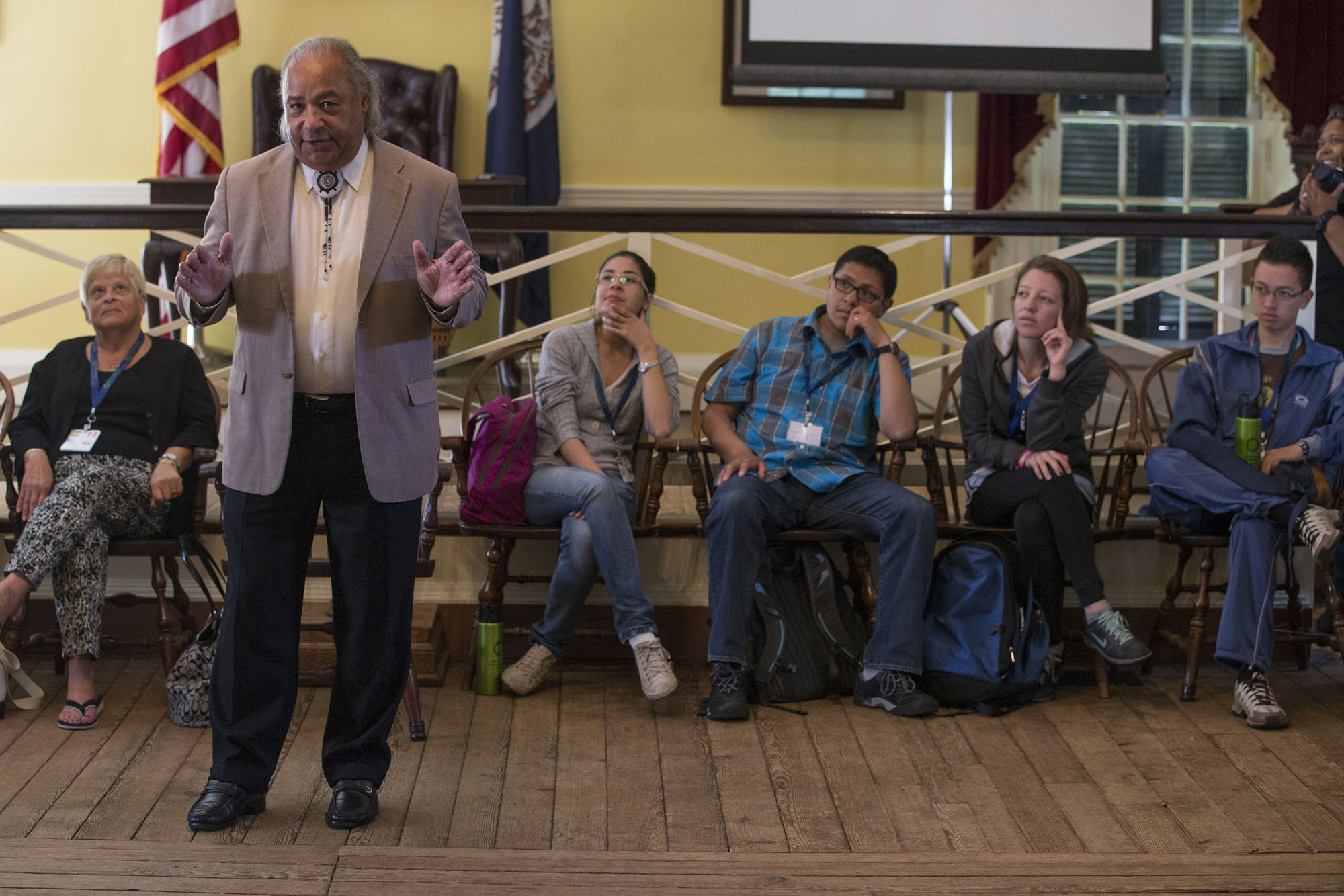As part of a Global Perspectives on Democracy Program led by the University of Virginia’s Center for Politics, 39 high school students from Bolivia, Ecuador and Peru gathered last week in Jefferson Hall.
There, Stephen Adkins, chief of the Chickahominy Tribe of Virginia, reflected on the American experience from the perspective of Virginia Indians, and emphasized how education is the best tool that indigenous people have to preserve their traditions and heritage.
“My primary responsibility to the Chickahominy people is to promote the value of education, to make sure all have access to a full, meaningful education,” Adkins told the students, who are in the U.S. for three weeks with the U.S. State Department’s Youth Ambassadors Program to learn about the importance of civic engagement, enhance their leadership skills and experience American culture.
Another responsibility as chief is civic engagement, Adkins explained. His community must exercise its right to vote in free, fair and open elections. All other rights depend on that right, he said.
Beyond that, Adkins has been active in local and state government, he said, primarily “trying to ensure the rights of our people are not overlooked.”
“How do you maintain Indian identity and yet live in another culture?” asked one student.
Adkins noted that he often explains how he lives in two worlds. During his 40-year career at DuPont, he often spent his days in management meetings, in the “white man’s world.” But every Friday he taught “Indian class” for his fellow Chickahominy.
The Chickahominy also hold community events like powwows to maintain and strengthen their sense of Chickahominy identity.
When Chickahominy youth near age 18, they often drift away from Indian culture, Adkins said, but many return to their roots when they mature into their 30s or 40s, he said. Though roughly 10 percent of students in the Charles City School System are Indians, and Indians are always among the top of each graduating high school class, they still feel sometimes feel ostracized and get mocked by other kids, who might do something like burst into war whoops.
“It’s tough to be Indian,” he said. “A large percentage of the U.S. population thinks Indians should be honored when a sports mascot comes out on a field and impersonates them with nonsense words and dancing.”
One student hinted at parallels in South America, where many indigenous groups struggle to maintain their ancestral lands, traditions and culture.
In her home country of Bolivia, one student explained, indigenous peoples make up more than 60 percent of the population, with 37 official languages aside from Spanish and more than 100 indigenous languages spoken. “We now have an indigenous president [Evo Morales], which I’m proud of, even though I don’t agree with all his policies.”
After speaking informally with some of the students, Adkins said, “Indigenous people across the Americas face the same challenges, some of the same kind of problems. Ever since the first European contact, people have tried to squelch our culture, to ‘Europeanize’ us.”
The Chickahominy first encountered European settlers within weeks of their landing in May 1607 at Jamestown Island. “Life for the natives, life for people like me, has never been the same,” Adkins said.
Before contact, the Chickahominy were one of largest tribes in eastern Virginia. In 1607, the primary leader of Virginia’s tribes was Powhatan, with more than 30 tribes under his control, but the Chickahominy were large enough – with a population of roughly 1,500 to 2,500 people – that Powhatan never made them subject to his rule. (Today there are about 1,300 Chickahominy living in Virginia, Adkins said.)
As an American Indian, “I’ve learned much about the dominant culture, but the dominant culture doesn’t know much about me, which was by design,” he noted. In Virginia, public primary and secondary schools teach Virginia history, but until recently it contained very little about native culture, little more than a mention of Powhatan and Pocahontas.
“You could successfully matriculate from [kindergarten] through Ph.D., even graduate from a top university like the University of Virginia, and have scant knowledge of Virginia’s indigenous people,” he said.
“I used to lament that fact, but never did anything about it. Now I have. I have served on the Virginia Standards of Learning framework committee, trying to make sure that the textbooks accurately reflect who we are. So often we were referred to in the past tense – like some historical oddity of the 17th century, and after that we didn’t exist.
“If you study the history of Virginia, and you don’t study the history of native culture, you haven’t gotten a complete history.”
But that is changing. In the latest iteration of the Standards of Learning, Adkins said, “We made tremendous strides.”
Media Contact
Article Information
September 22, 2014
/content/chickahominy-chief-tells-visiting-youth-education-s-importance-democracy

